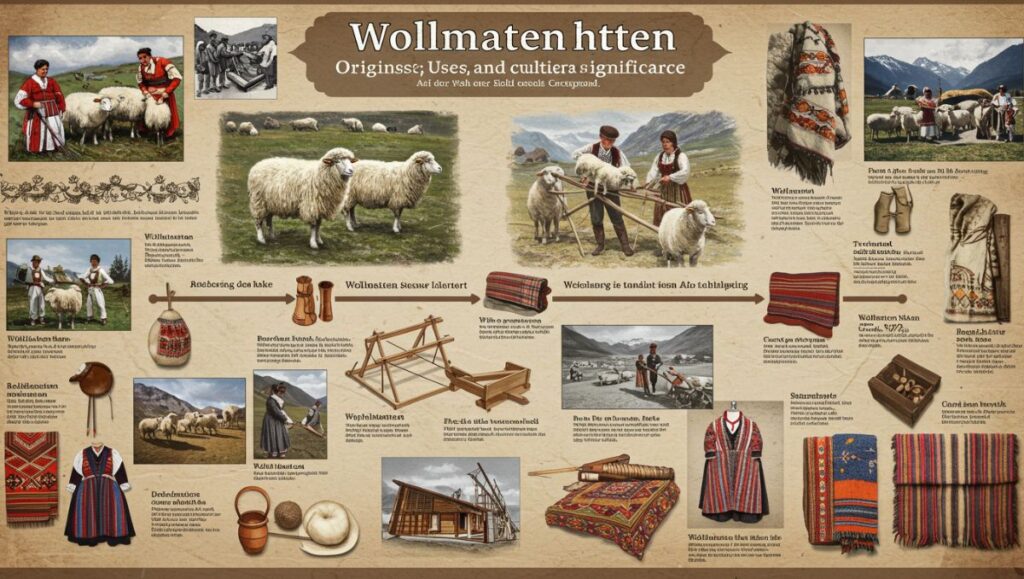Words often carry stories of tradition, craftsmanship, and identity. One such intriguing term is Wollmatten. At first glance, it appears German in origin, combining “Woll” (wool) and “Matten” (mats or layers). This immediately suggests connections to textiles, natural fibers, and handcrafted heritage. Beyond its literal meaning, Wollmatten can represent sustainability, artistry, and modern adaptation of traditional materials.
In this article, we’ll explore what Wollmatten means, its cultural and practical uses, and how it resonates in today’s world.
What Does Wollmatten Mean?
Breaking down the word:
-
Woll – Derived from “Wolle” in German, meaning wool, a natural fiber from sheep and other animals.
-
Matten – The plural of “Matte,” meaning mat, pad, or layered surface.
Together, Wollmatten refers to wool mats, wool layers, or padded items made from wool. These could be used for insulation, comfort, or decoration.
But Wollmatten is not just about fabric—it symbolizes the fusion of natural materials with everyday life, blending tradition with innovation.
Historical Context of Wollmatten
Wool has been central to human life for thousands of years, prized for its warmth, softness, and durability. In Europe, especially in German-speaking regions, wool production played a major role in rural economies.
Wollmatten historically could have been:
-
Floor coverings in rustic homes.
-
Sleeping mats for added warmth.
-
Protective layers in workspaces or outdoors.
These mats embodied resourcefulness, turning natural wool into practical household items.
The Practical Uses of Wollmatten
Home Insulation
Wool is naturally insulating and breathable. Wollmatten can be used in modern eco-friendly homes for soundproofing and thermal comfort.
Sleeping and Seating
Traditional households may have used wool mats as bedding layers or as cushions for seating areas.
Rugs and Carpets
Wollmatten can also refer to wool-based floor coverings, crafted for beauty and comfort.
Decorative Items
Handmade wool mats often double as aesthetic pieces, showcasing regional weaving techniques and patterns.
Wollmatten in Sustainable Living
In recent years, natural fibers like wool have regained importance in sustainable lifestyles. Unlike synthetic materials, wool is biodegradable, renewable, and durable.
Wollmatten fits perfectly into eco-conscious design by offering:
-
Natural insulation – Replacing chemical-based foam.
-
Non-toxic materials – Safe for children and sensitive individuals.
-
Longevity – High durability compared to synthetic mats.
This makes Wollmatten an eco-friendly choice for homes and businesses.
Craftsmanship Behind Wollmatten
Traditional Techniques
Handmade Wollmatten often involve spinning, felting, or weaving. These techniques preserve cultural heritage while producing durable products.
Modern Adaptations
Today, machines can produce large rolls of wool mats used in construction, gardening, or upholstery. Despite this, artisanal Wollmatten still thrive in craft markets.
Artistic Patterns
Artisans often incorporate colors, patterns, and textures to transform simple mats into decorative works of art.
Wollmatten in Gardening and Agriculture
Interestingly, wool mats are not only for homes—they are also used in agriculture. Farmers and gardeners use Woll matten as:
-
Plant protectors – Retaining soil moisture and reducing weed growth.
-
Animal bedding – Providing comfort and warmth for livestock.
-
Compostable layers – Enriching soil as they naturally degrade.
This highlights the versatility of wool mats across industries.
Cultural Symbolism of Wollmatten
Beyond practicality, Woll matten can symbolize:
-
Warmth and comfort – Reflecting the cozy essence of wool.
-
Tradition – Linking modern users to centuries-old craftsmanship.
-
Sustainability – Standing for eco-friendly and natural living.
-
Heritage – Rooted in Germanic and European textile traditions.
These symbolic layers add richness to the term.
Wollmatten in Modern Interiors
Interior designers increasingly value wool mats for their texture, natural feel, and ability to create cozy atmospheres. In Scandinavian and Alpine-inspired designs, Woll matten play a role in:
-
Softening minimalist interiors.
-
Bringing organic materials indoors.
-
Creating zones of comfort like reading nooks or meditation spaces.
Their combination of utility and beauty makes them popular in sustainable design movements.
Comparison: Wollmatten vs. Synthetic Mats
| Feature | Wollmatten (Wool Mats) | Synthetic Mats |
|---|---|---|
| Material | Natural, renewable wool | Plastic-based (polyester, nylon) |
| Environmental impact | Biodegradable, eco-friendly | Non-biodegradable, polluting |
| Durability | Long-lasting with proper care | Shorter lifespan, prone to wear |
| Comfort | Breathable, regulates temperature | May trap heat and odors |
| Symbolism | Heritage, tradition, sustainability | Mass production, modern utility |
This comparison shows why many are returning to natural choices like Woll matten.
How Wollmatten Are Made
-
Wool Collection – Shearing sheep or sourcing wool fibers.
-
Cleaning and Processing – Removing impurities and preparing fibers.
-
Felting or Weaving – Depending on the design, mats may be felted into thick pads or woven into patterned surfaces.
-
Finishing Touches – Adding dyes, textures, or decorative stitching.
These steps combine tradition with innovation, depending on whether the product is artisanal or industrial.
Global Appeal of Wollmatten
Although German in origin, the concept of wool mats resonates worldwide. Similar traditions exist in:
-
Mongolia – Felted wool mats used in yurts.
-
Scandinavia – Woolen rugs in cozy Nordic homes.
-
South America – Alpaca and llama wool mats in Andean cultures.
This global connection makes Wollmatten part of a larger story of humanity’s relationship with wool.
The Future of Wollmatten
As sustainability becomes more important, Woll matten are expected to gain popularity. Future uses may include:
-
Green construction – Eco-friendly insulation in homes and offices.
-
Luxury branding – Artisanal wool mats marketed as premium lifestyle products.
-
Digital design – Virtual worlds using textures inspired by Woll matten for realism.
Their timeless charm ensures they will remain relevant in both traditional and modern contexts.
Conclusion
Wollmatten is more than just a word—it represents history, sustainability, and craftsmanship. Rooted in the German tradition of wool mats, it connects us to a legacy of natural living and creative design. From eco-friendly home insulation to decorative artistry, Woll matten continues to evolve while retaining its cultural depth.
In a world searching for authenticity and sustainable solutions, Woll matten stands out as a reminder that traditional materials can inspire modern innovation.






